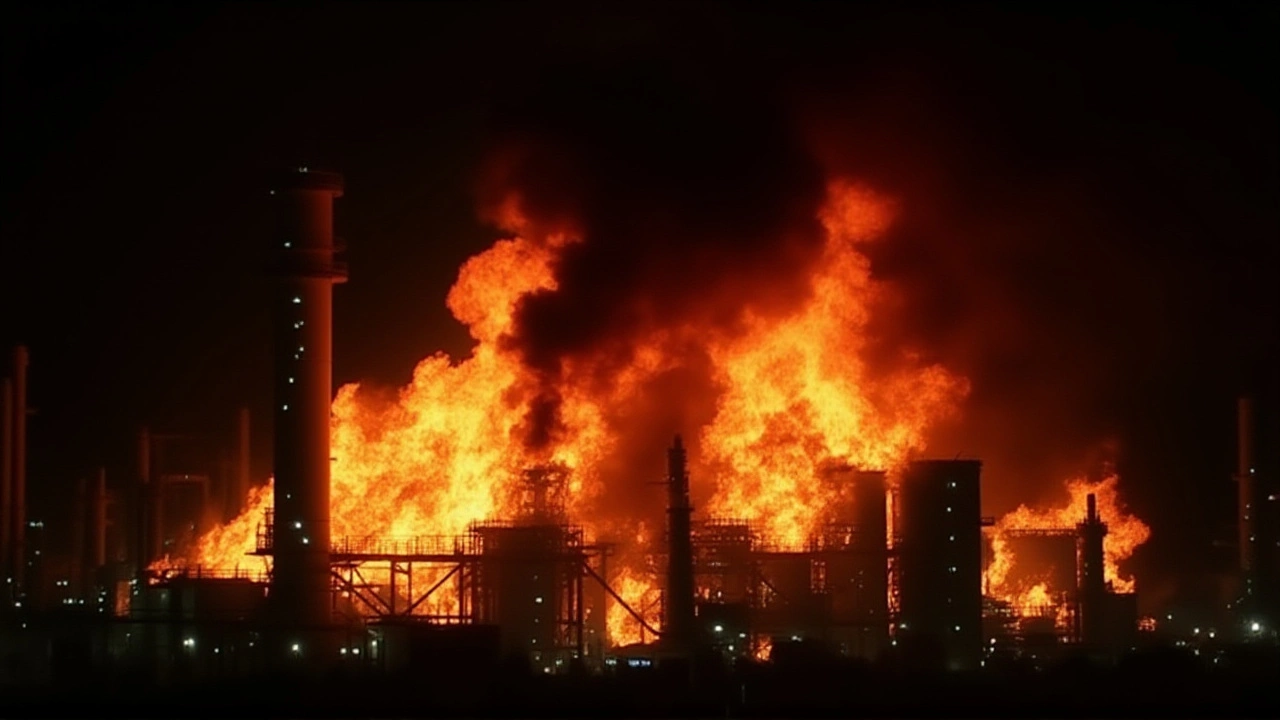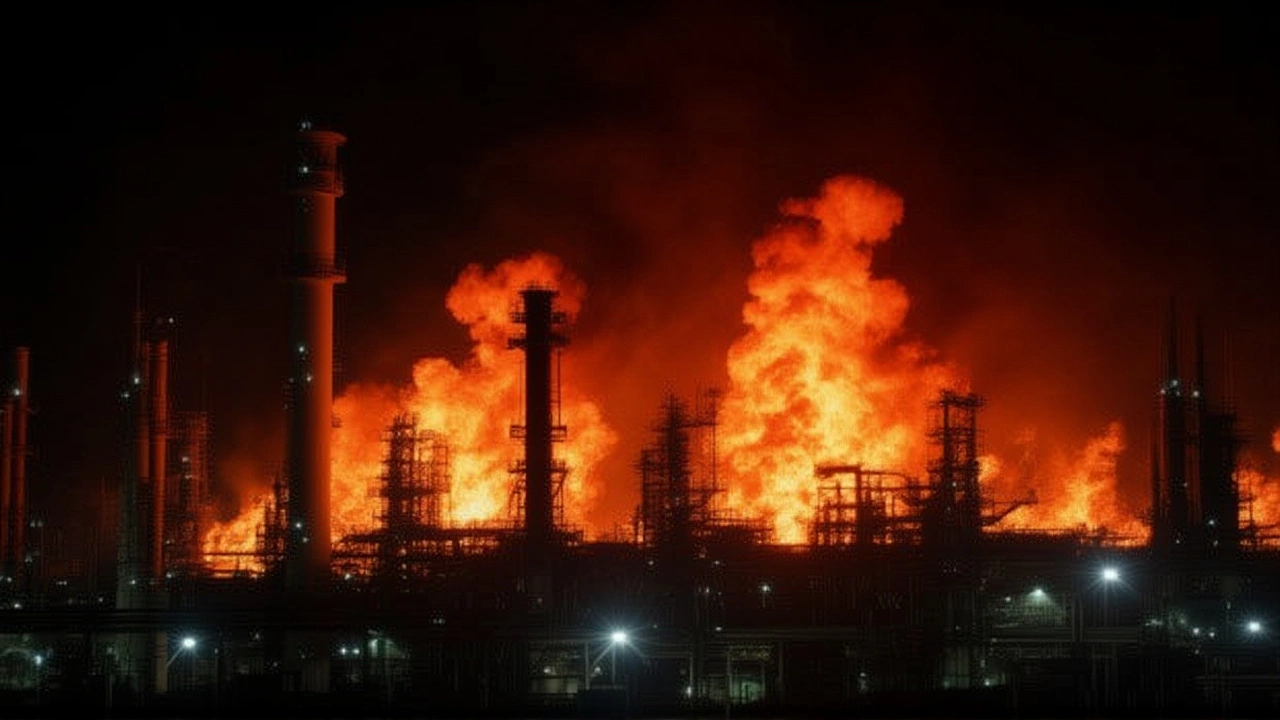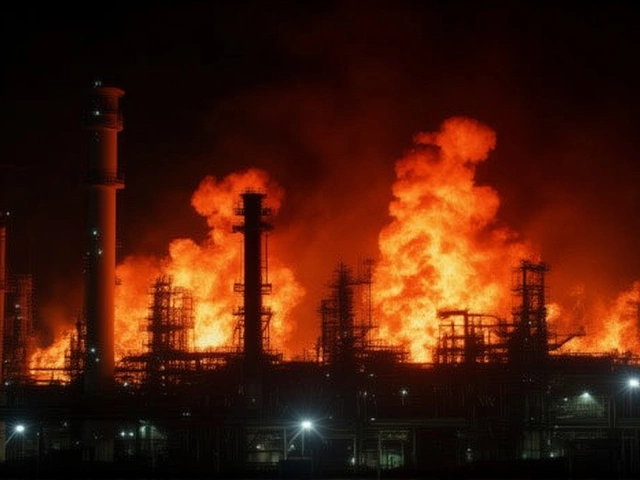When Mike Subrahmanyam, Senior Public Affairs Officer of Chevron confirmed that all staff were accounted for, a massive fireball still lit up the night sky over Los Angeles County. The blaze erupted at the Chevron El Segundo Refinery in the coastal suburb of El Segundo, California on Thursday, October 2, 2025, after an explosion sent flames soaring for miles.
What Happened and How Responders Reacted
The incident began just after 7 p.m. local time when a sudden blast ruptured a processing unit, sending a fireball that could be seen from downtown Los Angeles. Video footage posted by residents showed towering flames licking the sky, accompanied by a deep, resonant rumble that seemed to shake nearby windows. Within minutes, the El Segundo Fire Department and mutual‑aid crews from neighboring Manhattan Beach converged on the site.
Firefighters tackled the blaze with a mix of aerial water drops from a CAL FIRE helicopter and ground‑based foam lines. By roughly 10 p.m., the primary flame had been knocked down, though hot spots lingered well into the early hours of Friday. The Los Angeles International Airport, located just three miles north, temporarily adjusted its flight‑path procedures as a precaution, though no flights were delayed.
Immediate Safety Measures and Public Guidance
City officials urged residents within a one‑mile radius to stay indoors, close windows, and avoid outdoor activities until air‑quality monitors could provide a clear reading. The local health department set up a temporary hotline (555‑0199) for citizen concerns and dispatched mobile air‑monitoring units to schools and senior‑center facilities. Despite the dramatic visuals, the agency reported that pollutant levels stayed below the emergency threshold throughout the night.
Interestingly, the refinery’s perimeter fence‑line monitoring system—designed to trigger alarms for leaks—did not log any exceedances, a point Chevron highlighted in its post‑incident briefing. The company also emphasized that no evacuation order was ever issued, reflecting the confidence of emergency managers that the fire remained contained to the interior processing area.
Why This Refinery Matters to the Region
The El Segundo refinery processes roughly 250,000 barrels of crude daily, feeding a network of pipelines that supply gasoline and jet fuel to the Greater Los Angeles market. Its proximity to one of the nation’s busiest airports and several major freight corridors makes any disruption a potential ripple for fuel prices and logistics.
Historically, the site has endured two notable incidents: a minor hydrocarbon leak in 2012 that prompted a temporary shutdown, and a 2018 safety drill that exposed vulnerabilities in emergency‑response coordination. Both events spurred the California Energy Commission to tighten oversight, leading to more frequent inspections and upgraded fire‑suppression equipment.
Responses from Stakeholders
"Our priority has always been the safety of our employees and the surrounding community," Mike Subrahmanyam told reporters from the refinery’s control room. "We’re working closely with local fire agencies and will cooperate fully with any investigation that follows."
The California Air Resources Board announced a joint inspection with the U.S. Environmental Protection Agency to assess any short‑term emissions impact. Their preliminary statement noted that while particulate matter spiked briefly, concentrations returned to baseline within three hours.
Local elected officials, including Councilmember Ana Torres of El Segundo, expressed relief that the fire was contained without injuries but urged a transparent follow‑up. "We need to know exactly what caused this explosion and whether similar risks exist elsewhere in our refinery network," she said during a live‑streamed press conference.

Broader Implications and Future Outlook
Industry analysts are watching the incident closely because it arrives at a time when the nation is grappling with a tight fuel supply chain. The Energy Information Administration projected a 2.3 % rise in gasoline prices for the West Coast in the next quarter, partly due to refinery maintenance schedules. An unplanned outage—even a brief one—could tighten those margins further.
On the regulatory front, California’s Senate Bill 2 2023, which mandates stricter safety audits for facilities within 5 miles of densely populated zones, may see renewed legislative interest. Lawmakers are already drafting a proposal to require real‑time public dashboards for emissions data, a move that could have been accelerated if a significant health impact had emerged from this fire.
Key Facts
- Event: Chevron El Segundo Refinery fireEl Segundo, California
- Date & Time: October 2, 2025, approx. 19:10 PST
- Cause: Under investigation (preliminary focus on equipment rupture)
- Injuries: None reported
- Refinery capacity: ~250,000 barrels per day
What Comes Next?
Federal and state investigators, led by the National Transportation Safety Board and the California Division of Oil, Gas and Geothermal Resources, will begin a joint review early next week. Their mandate: determine the mechanical failure that triggered the explosion, assess compliance with recent safety mandates, and recommend corrective actions.
Chevron has pledged to provide daily updates on its website and to hold a town‑hall meeting for local residents within 30 days. In the meantime, air‑quality monitors will continue to sample the surrounding neighborhoods, and the refinery is expected to resume limited operations by early next month, pending clearance from regulators.
Frequently Asked Questions
What caused the explosion at the Chevron El Segundo refinery?
Investigators suspect a pressure‑vev failure in a crude‑distillation unit, but the official cause remains under review. Preliminary logs showed no abnormal temperature rise prior to the blast.
Were any workers injured during the fire?
Chevron confirmed that all refinery personnel and contractors were accounted for and that no injuries were reported.
How did the fire affect local air quality?
Air‑quality monitors recorded a brief uptick in particulate matter, but levels dropped back below the EPA’s health‑based thresholds within three hours, according to the California Air Resources Board.
Will there be evacuations or long‑term closures?
No evacuation orders were issued, and the refinery aims to restart limited processing by early next month after receiving clearances from state regulators.
What steps is Chevron taking to prevent a repeat incident?
Chevron says it will conduct a comprehensive safety audit, upgrade its pressure‑relief systems, and increase on‑site emergency‑response drills. The company also pledged full cooperation with the upcoming federal‑state investigation.

